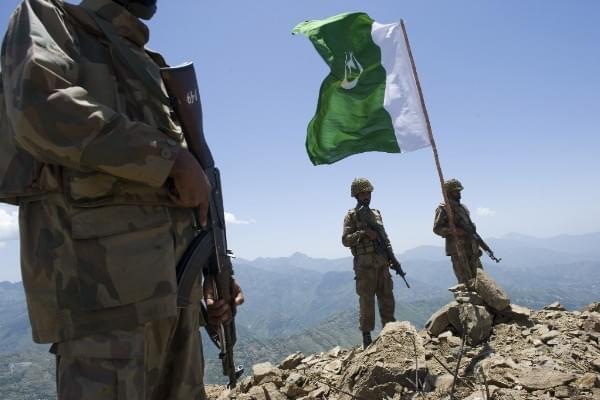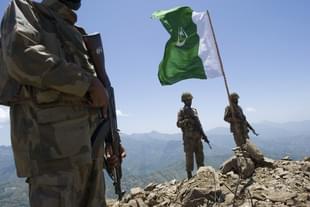World
Pakistan’s Grey Listing By FATF: Much More Than Meets The Eye
Syed Ata Hasnain
Jul 04, 2018, 11:30 AM | Updated 11:30 AM IST
Save & read from anywhere!
Bookmark stories for easy access on any device or the Swarajya app.


The Financial Action Task Force (FATF) met at Paris, France, at the end of June 2018 to discuss, among others, the most monitored issue – the status of Pakistan’s actions to curb transnational terrorism emanating from its soil. Pakistan presented a 26-point action plan covering the next 15 months in which it would address stated deficiencies in structures, especially those involving terror financing.
Surprisingly, on the day of the meeting, the Pakistan government issued directions removing Muhammad Ahmed Ludhianvi, the head of Ahl-e-Sunnat Wal Jamaat (ASWJ), from its terrorism list. The ASWJ is fielding a large number of candidates for the 25 July 2018 national election. It is known to be a party virulently opposed to the Shia sect of Islam, next only to the Sipaha-e-Sahaba, which is on the banned list; the Shia sect forms almost 13-15 percent of Pakistan’s 207 million population.
Pakistani authorities earlier boasted of the success of Operation Radd ul Fasad (RUF) to rid Pakistan off “unfriendly terrorist groups” – a euphemism for those groups which do not operate on its soil to the needs of its strategic plans to destabilise neighbouring India or Afghanistan. The Sipaha-e-Sahaba was under active targeting under RUF. It is known to have morphed into ASWJ to escape complete annihilation, although RUF actions may have left scope for selective revival for any state advantage envisaged at the later stages. In this meeting of the FATF, China, Turkey, and Saudi Arabia backed efforts to place constraints on Pakistan. That is all the more reason why Pakistan’s actions favouring the ASWJ become even more difficult to explain.
There is obviously much more than meets the eye in the murky world of violent Islamic sectarian politics linked to international interests. A couple of issues emerge upfront. First, it is well-known that Saudi Arabia has for long funded the growth of its brand of radical Wahhabi Islam internationally. Nowhere has this been felt more than in Pakistan and Afghanistan. It has also been reported that Saudi Arabia’s young Crown Prince Mohammad bin Salman is attempting to transform Saudi Arabia and its image by reducing such funding, which runs the radical seminaries and, through them, the various appendages of terror.
Such reduction may happen in many parts of the Islamic world, but in Pakistan there is a strategic advantage which Saudi Arabia seeks through such funding and that pertains to countering Iran. So on one hand, it makes for public posturing and proving to the world how much is changing in the Saudi attitude by backing the FATF plan to keep Pakistan on the grey list. On the other, the support to Wahhabi organisations in Pakistan is imperative, especially in Baluchistan, to retain advantage of the ideological support it can generate against Shia Iran across the border. Thus, clandestine funding and support to ASWJ continues, but that is yet no explanation for the rather brazen step to lift the ban on the AWSJ on the very day that FATF was going to be in session.
A method in the madness which could explain the action could be a link with the upcoming election on 25 July or an uncoordinated appeasement of the Saudis, who have different plans for different situations. What did appear clear was that Pakistan had no real intent to display a white-over-black attitude towards implicit follow-up on the FATF’s action plan.
The second issue is China’s stance. Having backed the FATF effort towards getting Pakistan to implement the 26-point plan and placing it on the grey list, China went against the traditional approach it has usually followed with Pakistan terror organisations. With much at stake in the stability of Pakistan to see the fructification of its strategic interests in the implementation of the Belt and Road Initiative (BRI) plan and the China-Pakistan Economic Corridor (CPEC), China would want Pakistan to implement the action plan in letter and spirit. It would also not wish to see any instability in Baluchistan or the Pakistan-Iran border, much against Saudi interests. Yet China sees an advantage where Pakistan places no controls on India-centric terror groups as it keeps India on the back foot. The reset in Sino-Indian relations has yet not gone far enough to witness any sudden change in this stance. Later this year, the issue of Masood Azhar and the Jaish-e-Mohammad will come up again in the Security Council. If any real change will be evident, it will be in China’s support towards declaring Azhar an international terrorist – something it has steadfastly avoided for the last few years.
What the FATF needs to re-examine is whether its proposed action during the 15-month monitoring period is sufficient deterrence for Pakistan. There are quarters within the Pakistan government which profess that they had withstood grey listing for three years in the past and can do so again. What is becoming evident is the complete lack of internal compulsion or public pressure on the ruling elements to put an end to terror. Through the current election campaign, not a word is being spoken about internal security – an issue that should have been at the centre of the agenda.
Writing in the Dawn, Aasim Sajjad Akhtar, a noted academic, stated last week – “…the ASWJ chief has been cleared to run for elections, not to mention Khadim Rizvi’s Tehreek-i-Labbaik Pakistan and the Tehreek-i-Allah-o-Akbar (read: Milli Muslim League or Jamaat ud Dawa). In short, political expediency plays out before our very eyes even while officialdom continues to spew rhetoric about eliminating all vestiges of terrorism”. Under such circumstances, the FATF’s acquiescence to give only a grey list status to Pakistan is itself questionable. Perhaps it is part of the expediency to get on board traditional international supporters of Pakistan and grey is the list up to which they could go to do that.
India would be realistic if it did not expect anything significant to emerge from the entire FATF process thus far or in the future. Yet it is a notable achievement that an international body of such import has again taken note of Pakistan’s waywardness. Indian efforts to push Pakistan into a corner with greater international isolation cannot succeed by just structured diplomacy. Our missions in important countries must develop the knowledge base, skill, and lobbying capability to take the issue to a higher level should Pakistan’s actions stop at just what suits the international community in relation to Iran and Afghanistan. It is the Pakistani employment of terror as a strategic weapon against India which must be focused upon by the FATF during the next 15 months.
The writer is a former GOC of India’s Srinagar based 15 Corps, now associated with Vivekanand International Foundation and the Institute of Peace and Conflict Studies.





